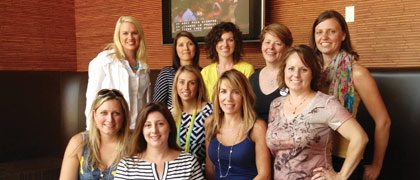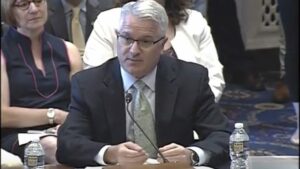Having ‘The Talk’
Proponents aim to transform monologues on the role of plant breeding in modern agriculture into healthy, accurate dialogues.
Being left out of a conversation, especially when the subject pertains to you, is unsettling. For some time now, the public has been engaged in wide-ranging discussions about modern agriculture without acknowledging or seeking input from the seed industry—the people who give us the means to grow our food, fuel and fiber. Tired of being talked about, often in inaccurate ways, seed industry advocates are searching for ways to pull even with consumers’ current conversations and begin to frame future ones.
Janice Person (back row, second from right) was one of several ag-related bloggers who met up at the BlogHer 2013 conference in July in Chicago to network with their counterparts from around the country.
How Did It Happen?
Public interest in food and how it gets to the dinner table isn’t a new phenomenon, but according to author and agricultural advocate Michele Payn-Knoper, several factors have pushed it to higher prominence recently. She points out that more than 98 percent of the U.S. population does not live on a farm or ranch. This fact, coupled with increased media-driven sensationalism around food safety, biotechnology, animal welfare and the environment creates one-sided conversations. “Rather than look at this as negative, I actually think it opens more doors for agriculture to connect with food interests,” says Payn-Knoper.
The means through which information gets shared, especially with the advent of social media, has created an environment where consumers are bombarded with an array of opinions about agriculture, notes Janice Person, who heads up Monsanto’s social media efforts. “A lot of the general public is passively consuming information. We have always been interested in food; we simply have a constant feed of [information about food] now,” she says.
American Seed Trade Association president and CEO Andy LaVigne notes that many of the important innovations introduced through seed breeding in the last 10 to 15 years had the biggest impact out in the field. “Many of those traits were most beneficial to the farmer with a secondary benefit to the consumer, whether it was a reduction in emissions or input costs. Those are hard for consumers to put their fingers on,” he says.
Fortunately, that is likely to turn around in the near future as more seed varieties offer direct benefit to the consumer. New soybean varieties that produce oils lower in trans fats or with higher oleic acid contents, or new varieties of fruits and vegetables that are more tolerant to weather extremes—these are the kind of ag stories that are likely to resonate better with health and cost-conscious shoppers, LaVigne says.
Is a Science Lesson in Order?
Besides being far removed from food production, the majority of the U.S. population has a hard time understanding the science behind seeds. Trying to explain the principals of genetics can be overwhelming. “A lot of people have a tough time grasping what companies go through to bring new products to the market. We can give examples like new colors of roses or that hardier plant or shrub for your yard, but the challenge is how do we explain seed breeding to the consumer in a way that inspires confidence, not confusion?”
Unfortunately, many misperceptions about modern seed breeding are rooted in ignorance over scientific truths. LaVigne notes his organization must often address the assumption that researchers are experimenting in a new science that’s done behind the closed doors of a laboratory. “Like any science, breeding has evolved,” he says. “Some work is done in the lab but we have to grow out the varieties and see if it’s what we’re anticipating. A lot of people don’t grasp the concept that unlike a product that’s produced in a factory and can be shipped anywhere, a plant has to be adapted to some regional aspect. Companies have to breed for local agronomic issues whether its climate or soils or tolerance.”
Then there’s the perceived skepticism towards the use of technology in creating better plants and seeds. “We benefit much like other sectors from new innovation in technologies and scientific methods. Today researchers are able to look at the human genome, as people age or get sick, to understand what’s happening. We can use that same kind of technology to figure out what makes a plant sick and what can be done to make it stronger,” says LaVigne.
Become a Resource
Bridging that kind of information gap is daunting, but Payn-Knoper and Person, who have devoted their careers to spanning that chasm, say it’s doable. Focusing on the consumer’s deficiencies isn’t the best place to start. “Those of us who spend our lives in agriculture want to jump right into correcting misinformation, when simply opening a broad conversation will get us much further in the dialog,” says Person. “Of course, we need to be sure we are putting out good information on the ‘hot topics’ as well, but in my opinion, the easiest way to get in front is to be considered a resource on agriculture.”
It’s easy to become defensive when someone starts asking questions, Payn-Knoper notes. “The general public doesn’t realize how deeply personal farming is to us. They simply want to know they’re taking care of their families and making the right choices around food. We need to help them feel good about making food decisions, listen to their concerns and try to answer questions.”
Payn-Knoper believes making personal connections is the key to becoming that resource, whether it’s to a farmer who blogs or a seed executive who uses Twitter. Sharing perspectives unique to the 1.5 percent of the U.S. population who works in agriculture is a must, she says. “The bigger question is whether you’re willing to share your expertise in a way that is meaningful to people with an interest in food. We have to learn to translate our passion to their passion.”
At the moment, social media is the most popular method for outreach efforts within the non-farm community, but companies have found success through other venues too.
Monsanto has used an array of tools through their America’s Farmers program in an effort to make that connection. In addition to using traditional advertising outlets and establishing an online presence, the company has found success through hosting contests that honor and reward hard working farm moms, rural school districts and non-profit organizations, according to Person.
One of the newest industry-wide efforts to engage healthy conversations about agriculture is the creation of a new online forum, GMOanswers.com, where the public is encouraged to ply the experts with questions about genetic engineering in food production.
What’s at Stake?
If the seed industry can’t ‘catch up’ with the conversations going on now, what kind of outcomes should be expected? Serious ones affecting the long-term viability of agriculture as we know it, leaders say.
“Agribusinesses have a critical part in the three-way relationship with farmers and consumers; both in helping more farmers understand ways to better share their story and in having employees take responsibility for sharing their story. We will lose the right to farm as we best see fit if we can’t connect our practices more effectively with the general public. And as farmers lose their right to farm, you will lose your right to do business,” Payn-Knoper says.
LaVigne says it’s imperative that researchers retain the tools they have currently and are able to explore new ones for the sake of food security. “We’re not making any new farmland. We’re losing it to development. That means improved yields need to be seen on the acres we have left, and that responsibility comes back to the seed industry. We’ve got to bring those innovations to the marketplace for the farmer.”











